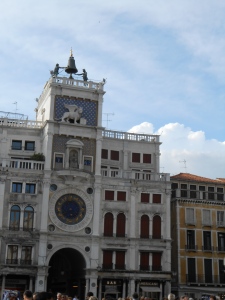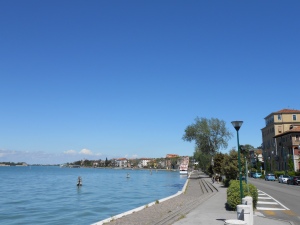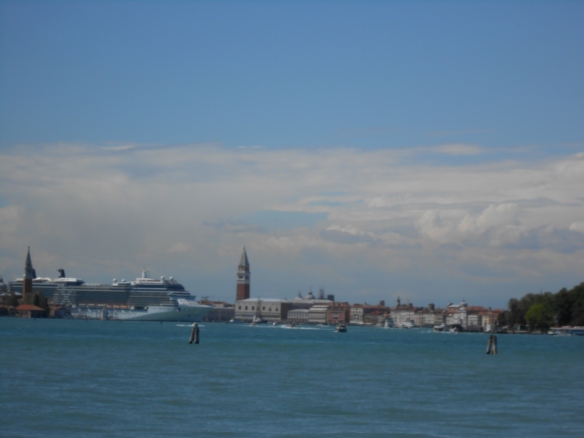Our first twenty-four hours in Europe have been spent in Venice, as beautiful and intriguing as it is multi-faceted and elegantly worn in places. Two items of note were immediately apparent to me: water in the canals and lagoon was the cleanest I’d ever seen (or smelled), and, major strides in public works. Everywhere we went, on canals and land, many buildings both grand and small had been repaired and shorn up or were under repair.
One thing that had not changed was to arrive in Italy with our luggage MIA. This is now two out of three times we’ve arrived in Italy by air sans baggage. All the other trips have been by train or car, with ne’er a mishap in the baggage department. Unlike the last time, our luggage was delivered before 24 hours was out. Four years ago we’d learned how such fun it was to arrive in Italy after an African safari and live out of carry-on bags for 5 days.
Back to Venice. As this was not our first time here, we chose to catch a few of the de rigeur sights previously unseen, then focus on lesser-known places we’d not yet seen. But first: a balmy first evening was spent elbowing our way through the crowds at the Piazza San Marco where we succumbed to blatant tourism and enjoyed a glass of wine while people-watching on the piazza. Despite the crowds, it was delightful.

The Basilica of San Marco, with flags in the foreground. San Marco is the patron saint of Venice. The three flags from left to right represent: the European Union, Italy, and the red and gold lion of Venice.
An interesting legend about the Torre dell’Orologio (clock tower) is an illustration in how the best laid plans of mice and Venetians can lead a city to shoot itself collectively in the foot. Built in 1497, this elegant gold-leaf clock was a unique feat of engineering for its time. In order to prevent the secrets of its mechanisms from subterfuge, the inventors of the clock were assassinated to prevent rival cities of learning its secrets. Unfortunately, the clock’s mechanisms broke down, and the bells rang at random hours forever until finally repaired in recent times.
The next day we toured the Palazzo Ducal (Ducal Palace), also located on the Piazza San Marco. Somehow, we’d managed to miss this Venetian chestnut the first few times. It is well worth the lines, especially if you’re a lover of the painter Veronese, who seems to have illustrate many of the ceiling frescoes in the palace. Guidebook can fill in the palatial details; I’ll only make a few comments.
First, the palace was not just residence of the Doge or Duke of Venice. It also housed all three of the city government, equivalents of our executive, legislative and judicial branches. Secondly, unlike most European cities of the middle ages, the head of state wasn’t hereditary, but an elected official. However, being the choice of the “people” (via the equivalent of the city council) didn’t stop at least one doge from being deposed and executed. I guess this brings the meaning of the “will of the people” to a head. (Sorry, couldn’t resist.)
Tired of the crowds, we hopped a vaporetto (water bus) to Lido, the barrier island east of Venice that serves as both a suburb and beach town for Venetians. The Lido was quiet, with absolutely no crowds, and beautiful beaches on the Adriatic side of the island.
We were enjoying a peaceful post-prandial stroll along the quay when Michael exclaimed, “What is that! Will you look at the size of that thing!” I returned with a puzzled, “What?” and Michael said, awe-stricken, “It’s a giant cruise ship. It looks like it’s going to swallow Venice whole.” And for the next ten minutes we watched with amazement as this humongous behemoth, the Celebrity Solstice, cruised down the canal between Guidecca and Venice, indeed looming over the city like a monster swallowing a fish.
Hotel San Cassiano
Our hotel, the San Cassiano, could not have been better situated. A 14th century mansion, this “Residenza d’Epoca” (subtitle #1) served as the home of various Venetian nobility, according to its brochure. In the 19th century the painter Giacomo Favretto lived in the mansion, giving it the name “Ca’ Favretto” (subtitle #2). From the hotel’s balcony and private pier, we could sip a glass of wine at sunset while overlooking the Ca D’Oro on the other side of the Grand Canal. Except for the three-line name, a very nice hotel indeed.
Getting Cozy with the Locals
I will end with a humorous if embarrassing story. The first morning after arriving in Venice, Michael and I boarded a crowded vaporetto headed for San Marco. The conductor allowed far too many people on board, and as I felt the press of people from behind, the boat lurched away from the dock. I clutched Michael’s arm and hung on for dear life so I wouldn’t stumble in the press. As I continued to cling to his arm, I saw this woman in front of me starting to giggle uncontrollably, cutting her eyes up at Michael. As I tried to figure out what was going on here, Michael’s face – behind the woman – came into focus. Horrified, I looked up to see I’d been clutching to my side the arm of a total stranger, the boyfriend of the giggling young woman, a man about the same height and build as Michael, wearing a dark windbreaker. Horrified, I dropped his arm and started apologizing profusely (more like babbling in embarrassment). They were both great sports about the incident, the woman insisting repeatedly, “No, no don’t apologize, it was so cute!” Michael, needless to say, never let me hear the end of it!






